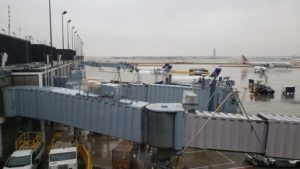Technology is changing how we design and operate airports and it is also transforming the customer experience. Max Hirsh, professor at the University of Hong Kong and a leading expert on airports and urban infrastructure, explores how smart airports are leveraging those changes to redesign the passenger journey
Smart cities, smart airports: these are buzzwords that we’re hearing more and more. It’s clear that technology is changing how we design and operate airports, and it’s clear that tech is transforming the passenger experience.
In the first article in this series, we looked at how smart airports are embracing new technologies that deliver a clear return on investment. This article will focus on how smart airports are redesigning the passenger journey.
In recent decades, aviation has undergone huge technological changes. Today, I can download my boarding pass, travel to the airport, check my bag, clear immigration, buy a snack and board my flight, all without interacting with another human being. At least in theory.
The reality, of course, is much messier. Over the years, we’ve inherited a hodge-podge of operational practices that persist even when technical advances have made them obsolete. Smart airports aren’t afraid to ask if these legacy procedures still make sense. And whenever possible, smart airports try to combine processes – or eliminate them entirely – in order to simplify the passenger journey.
Let’s look at three examples:
From landside to airside

In most countries, when travelers depart on an international flight, they have to line up twice: once to clear security, and once again to pass through immigration. This double-queuing is one of the most tedious aspects of the entire passenger journey, as travelers waste precious time that could be better spent shopping, eating, or relaxing before their flight. How can security and immigration facilities be redesigned, and how can staff be retrained, to make that experience more pleasant?
Expanding the use of self-scanning e-gates – and passengers’ eligibility to use them – is a step in the right direction. A recent survey by SITA revealed that passengers who use e-gates are more satisfied with their immigration experience compared to those who interact with border agents. That doesn’t mean that we should entirely eliminate the human factor. Deploying staff to check travelers’ documents while they wait, and to help people who are unfamiliar with screening procedures, can significantly reduce queuing times for everyone.
Thinking ahead, smart airports are exploring how facial recognition will empower them to combine security and immigration into a single process, thereby simplifying how passengers move between the landside and airside. In the near term, improvements in biometric technology may even render that division obsolete. That has big implications for terminal design.
Rethinking luggage

Smart airports also ask themselves if a particular process necessarily needs to take place inside the terminal itself, or if it can be better accomplished somewhere else. In the 1990s, Hong Kong led the way by building two in-town check-in terminals where travelers can drop their bags and get a boarding pass without leaving the CBD. Some airlines even let you do that the day before your flight. Other cities (e.g. Vienna, Seoul) have followed suit, but the practice has yet to catch on in major markets like the USA. That’s unfortunate and ironic, given that one of the world’s first downtown check-in terminal was, in fact, located in Midtown Manhattan.
Getting rid of bags early on in the passenger journey makes a lot of sense. When designing terminals, airport planners budget in extra time and space for people traveling with luggage, since they’re slower and take up more room as they move. When I interview passengers, they tell me that carrying luggage is one of the most stressful aspects of flying: it’s heavy, and they’re worried that their belongings will get lost or stolen. That correlates with the findings of travel retail experts, who note that the more weighed down passengers feel by baggage, the less likely they are to shop at the airport.
Off-site check-in terminals are one way to help travelers deposit their luggage before they even arrive at the airport. Pop-up bag-drop facilities at festivals and trade fairs can also help airports manage the spikes in traffic that accompany such large events. Baggage pick-up services at the customer’s home or office, offered in London and Dubai for example, is another smart strategy. And over in the USA, some forward-thinking airports are partnering with ridehailing apps, installing bag-tag printers inside the vehicles that passengers use to travel to the airport.
Thinking way outside the box, some of us in the industry are wondering if passengers really need to fly together with their luggage on the same plane. Couldn’t bags be transported more efficiently by, say, FedEx? Doing so would give passengers greater ability to track the whereabouts of their belongings, and greater choice of pick-up and drop-off points. But it would also have major consequences for the airline revenue model, and for the way we design the arrival experience. Could baggage carrousels become a thing of the past?
The takeaway: smart airports are rethinking how passengers travel with their luggage, and are outsourcing bag drop-off, transfer and delivery through a variety of creative approaches. These industry leaders develop solid partnerships and innovative profit-sharing models between airports, airlines, ground handlers, and local transportation operators.
From terminal to aircraft

The past half century has seen profound changes in both terminal design and aircraft design. But the interface between the airport and the airplane – the airbridge – has remained essentially the same. We’ve tweaked it to accommodate aircraft of different sizes, but we don’t really question the basic way that planes connect to the terminal. Waiting inside an airbridge – often a windowless tube that is blazing hot or freezing cold – is one of the least pleasant aspects of the passenger journey. It’s also the last impression that travelers have of your airport.
As Benoy’s Simon Bee pointed out at a recent conference in Singapore, our reliance on airbridges poses a significant barrier to innovating the relationship between the airport and the airplane. Smart airports are rethinking that relationship. One way is to expand the existing terminal structure onto the tarmac, in parallel to the aircraft stand, in order to create more space inside the terminal and more entry points to the plane. Another option is to design direct links between airline lounges and aircraft. That would allow premium passengers to board more quickly, while also reducing congestion at the gate.

Final thought
Redesigning the passenger journey – through clever uses of technology, design and manpower – promises to significantly increase customer satisfaction. It can also be a big win for airport operators, who can reduce costs and increase capacity inside space-constrained terminals.
At the same time, smart airports recognize that resistance is an inevitable part of innovation. Passengers and employees may be unwilling to change their habits, particularly when confronted by new technologies. And numerous parties within the aviation industry have a vested interest in maintaining outdated operational practices, even when those practices constrain future growth and drive down the customer experience.
Smart airports – and the men and women who lead them – tackle those barriers head-on. They deploy intuitive technologies that passengers find easy to use. They invest in the technical literacy of their employees. Above all, smart airports understand that innovating the passenger journey will also drive innovations in the airport business model, as old revenue sources and cost centers are replaced by new ones. But that’s a topic for another time.
This article is the second in a series about what makes an airport ‘smart’ and was originally published here.
About the author
 Max Hirsh is a professor at the University of Hong Kong and an expert on airports and urban development. He provides thought leadership for the aviation industry through his website airporturbanism.com.
Max Hirsh is a professor at the University of Hong Kong and an expert on airports and urban development. He provides thought leadership for the aviation industry through his website airporturbanism.com.

